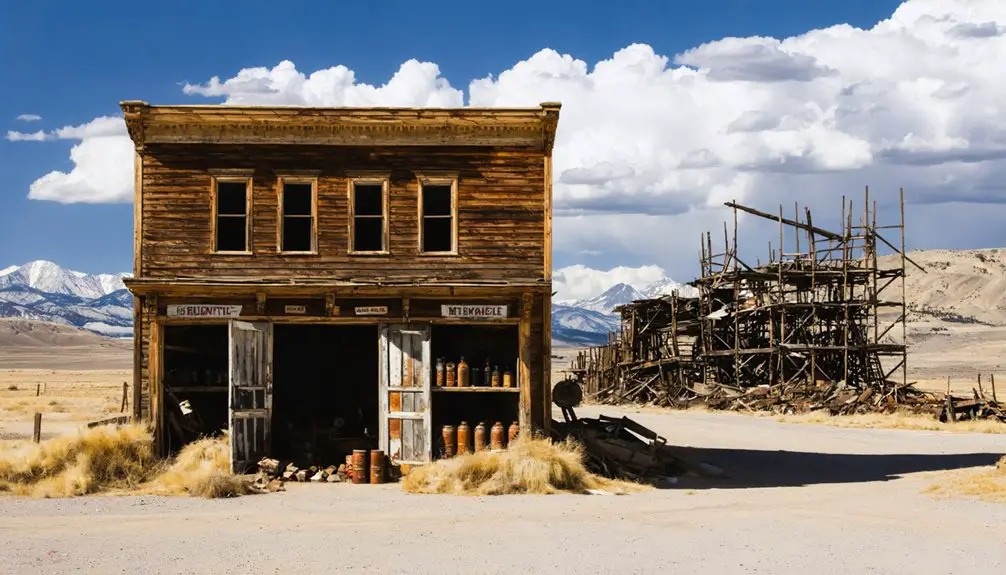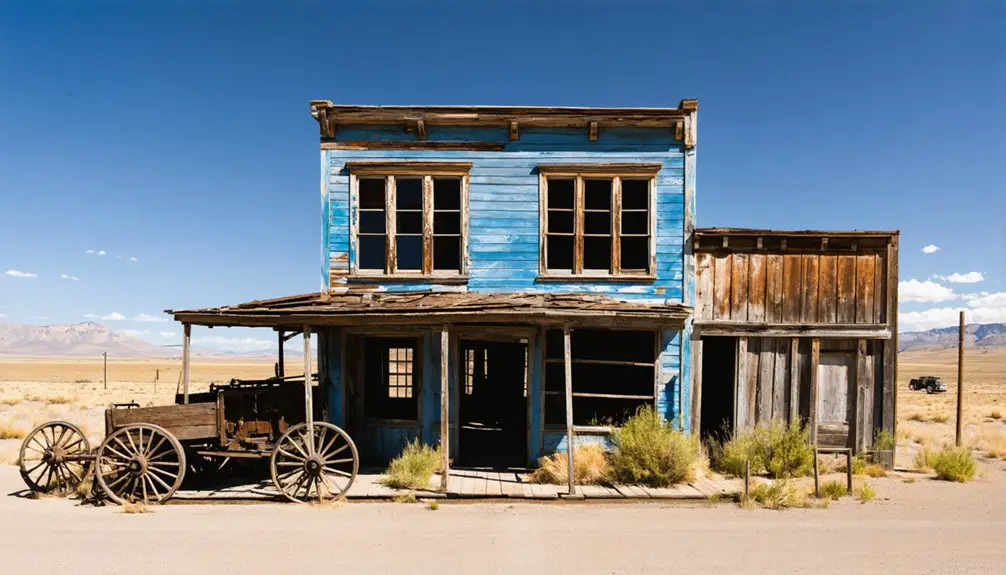You’ll find Bessemer’s ghost town remains 12 miles southwest of Casper, Wyoming, at a historic bend in the North Platte River. Founded in 1888 by the Wyoming Improvement Company, this “Queen City of the West” briefly flourished with stores, a hotel, and nearly 2,000 residents pursuing dreams of iron, coal, and oil wealth. Without a railroad connection and failing to deliver on its mineral promises, the settlement faded before 1900. The site’s strategic location still tells tales of pioneer crossings and western ambitions.
Key Takeaways
- Founded in 1888 near Casper, Wyoming as a mining boomtown promising abundant iron ore, coal, and oil deposits.
- Marketed as the “Queen City of the West” with 49 platted blocks and early infrastructure including stores, hotel, and newspaper.
- Population peaked at nearly 2,000 miners but declined rapidly when promised mineral wealth proved nonexistent.
- Town’s failure primarily stemmed from lack of railroad connection and overstated claims about local natural resources.
- Located at historic Bessemer Bend, the site remains significant for its role in westward migration along the North Platte River.
The Birth of a Frontier Dream
In 1888, the Wyoming Improvement Company established Bessemer at a strategic bend of the North Platte River, just 12 miles southwest of Casper. Named after steel innovator Sir Henry Bessemer, the town’s founding vision reflected the region’s perceived mineral wealth, with promising deposits of iron ore, coal, and oil surrounding the settlement. The distinctive red sandstone terrain defined the surrounding landscape.
You’d have found a bustling frontier town taking shape, with forty-nine platted blocks and land set aside for Wyoming’s future capitol building. The community’s aspirations soared as high as the nearby Red Buttes, earning Bessemer the nickname “Queen City of the West.” The town’s promotional advertising folders in 1889 highlighted its abundant resources and advantages to potential settlers.
Initial development brought essential businesses – stores, a hotel, saloons, and even the Bessemer Journal newspaper. The town’s location near Speas Spring and fertile river lands, combined with anticipated railroad connections, seemed to guarantee a prosperous future for this ambitious settlement.
Life at Bessemer Bend
If you’d visited Bessemer Bend in its heyday, you’d have found a bustling trading post where pioneers gathered to rest and resupply at the town’s three stores, hotel, and saloon.
The North Platte River crossing brought a steady stream of travelers who’d camp near the bend, making it a natural hub for commerce between settlers, miners, and emigrants on the westward trails. Local lore tells of mysterious sightings of ghost ships in fog appearing on the river’s waters.
You could watch wagon trains ford the river while townspeople traded supplies, shared news from the Bessemer Journal, and conducted business at the livery stable, creating a typical scene of frontier life. The town’s founders had ambitious plans, even setting aside land in hopes of making Bessemer the future capital of Wyoming.
Daily Pioneer Activities
Life at Bessemer Bend centered around the demanding rhythms of mining work, where laborers spent grueling hours extracting precious metals using basic hand tools and early mining technology.
You’d find yourself following strict mining routines, working from sunup to sundown in harsh conditions, battling severe weather and constant safety risks underground.
After your shift, you’d head to the town’s saloons or gathering spots, where community gatherings offered a brief escape through card games and storytelling.
Similar to Atlantic City’s peak days, the town briefly sustained a population of nearly two thousand miners during its most productive period.
You’d trade with local merchants for essential supplies, often bartering or using cash from your mining wages.
Daily survival meant dealing with limited medical care, unreliable food supplies, and primitive sanitation.
At Bessemer Bend’s crossing point, you’d encounter travelers and freight haulers, making the town a crucial hub for regional commerce and movement.
The town’s hopes were tied to the Bessemer steel process, but the mines ultimately proved too unprofitable to sustain the community.
River Trading Post Life
Situated at a crucial bend in the North Platte River, Bessemer’s trading post served as the last affordable water crossing before emigrants faced costlier toll stations downstream.
You’d find this bustling hub of river commerce and pioneer interactions nestled about 10-12 miles southwest of Casper, Wyoming, near the distinctive Red Buttes landmark. Similar to the pioneers who got lost on the Lincoln Highway route years later, travelers relied heavily on clear markers and guidance to navigate the area safely.
The area was particularly vital as it provided the last safe water for travelers facing a challenging 20-mile stretch ahead.
At this strategic location, you could’ve experienced:
- Lively trade between Native Americans, settlers, and westward emigrants
- Essential services from blacksmiths, saloons, and general stores
- Regular Pony Express riders passing through on their routes
- Community gatherings at the local brewery and newspaper office
You’d witness Miss Clementine Evans teaching at the local school while wagon trains stopped for rest, supplies, and safe passage across the North Platte’s waters.
Natural Resources and Economic Promises
You’ll find Bessemer’s founding dreams were built on the red hills surrounding it, which investors believed signaled rich iron ore deposits beneath the surface.
The Wyoming Improvement Company marketed the area’s supposed mineral wealth aggressively, promising investors a future industrial powerhouse built on iron, coal, and oil extraction.
Despite these grand promises and initial commercial growth, the natural resources proved less abundant than hoped, and the town’s economic aspirations went unrealized.
Iron Ore Dreams
Three powerful geological indicators sparked dreams of an iron-rich future for Bessemer, Wyoming in 1888: the distinctive red shale and sandstone hills containing iron oxide, the proven deposits in the Hartville complex, and the promising formations near Rawlins and Seminoe.
The Wyoming Improvement Company boldly marketed these iron extraction prospects, envisioning Bessemer as Wyoming’s future industrial powerhouse. Like the Gogebic Range which produced over 325 million tons of high-grade iron ore during its productive years.
You’ll find evidence of their ambitious vision in these early promises:
- Establishment of major iron mining techniques and operations
- Development into Wyoming’s potential state capital
- Creation of a significant railroad and manufacturing hub
- Integration of iron ore processing with nearby coal resources
Though the iron ore required extensive processing to reach usable concentrations, early investors remained convinced that Bessemer’s natural resources would transform it into a thriving industrial center. Despite this early optimism, studies would later reveal approximately 200 million tons of untapped iron ore reserves in the region.
Resource Claims Unfulfilled
Despite the Wyoming Improvement Company‘s grand promises of abundant natural resources, Bessemer’s actual mineral wealth proved dramatically overstated. You won’t find evidence of the “richest oil fields” or “immense coal deposits” that promoters claimed would fuel the town’s industrial growth.
Instead, this classic case of resource speculation led to widespread economic disillusionment. The town’s initial infrastructure – including a hotel, saloon, and three stores – couldn’t sustain itself when the promised natural resources failed to materialize.
Without successful oil extraction or coal mining operations, Bessemer couldn’t attract the railroad expansion or industrial investment needed for long-term survival. By December 1890, even the town’s newspaper, the Bessemer Journal, had suspended operations, marking a symbolic end to those unrealized dreams of resource-driven prosperity.
Transportation Hub and Historic Crossroads
Located at a pivotal bend in the North Platte River, Bessemer emerged as an essential transportation nexus where multiple westward trails converged.
The site’s historic significance grew as the last major river crossing before toll ferries, serving pioneers seeking freedom on the westward journey.
You’ll find evidence of Bessemer’s transportation evolution through these notable features:
- A 300-yard-wide river crossing used by Oregon, California, and Mormon Trail emigrants
- The strategic Red Buttes Pony Express and Overland Stage stations
- A bridge spanning the North Platte River built to support industrial ambitions
- The historic DUX Bridge, constructed in 1922, now on the National Register
The site served as the final fording location along the 450-mile North Platte trail from Fort Kearney, marking a significant waypoint for travelers pushing westward.
The Short-Lived Boom Years

While frontier towns often sprung up overnight across the American West, Bessemer’s founding in 1888 marked an ambitious venture by the Wyoming Improvement Company. You’d have found a bustling settlement of forty-nine platted blocks, where boom prospects centered on the region’s promising iron ore, coal, and oil deposits.
The town’s early infrastructure reflected its community aspirations, with three stores, a hotel, livery stable, and the *Bessemer Journal* newspaper serving the growing population. You could’ve caught the twice-daily stagecoach to Casper, dined at the local restaurant, or conducted business at the newly constructed bridge over the North Platte River.
Plans for a brewery and wholesale liquor business in 1890 showed the town’s diversifying economy. Yet without the vital railroad connection, Bessemer’s industrial dreams remained unfulfilled, and the boom faded before 1900.
Legacy Along the North Platte River
Though Bessemer’s industrial ambitions never materialized, its legacy endures through its historic North Platte River crossing at Bessemer Bend.
You’ll find this significant location 12 miles southwest of Casper, where the river once stretched 300 yards wide and challenged countless pioneers heading west.
At this vital river crossing, you’ll discover:
- The last major fording point on the 450-mile North Platte Trail from Fort Kearney
- A convergence of the Oregon, California, Mormon, and Pony Express routes
- The historic 1922 Warren truss bridge, recognized by the Historic American Engineering Record
- Red Buttes landmark, which guided emigrants before they turned southwest toward South Pass
Today’s Bessemer Bend National Historic Site preserves this important piece of western migration history, where you can walk in the footsteps of pioneers who shaped America’s westward expansion.
Traces of Wyoming’s Westward Expansion
As the remnants of Wyoming’s westward expansion unfold around Bessemer, you’ll find a rich tapestry of pioneer history dating back to 1812, when Robert Stuart built the territory’s first cabin near Bessemer Bend.
You can trace the area’s frontier settlement evolution through the establishment of nearby Fort Laramie in 1834 and the surge of over 400,000 emigrants who traversed the region’s network of trails between 1841 and 1868.
The transformation accelerated when the Union Pacific Railroad arrived in 1867, turning the North Platte River corridor into a crucial transportation route.
The arrival of Union Pacific’s iron rails in 1867 revolutionized transport along the North Platte, forever changing Wyoming’s landscape.
Bessemer’s history mirrors Wyoming’s broader development, from early fur trading outposts to military installations and eventually thriving ranching operations that defined the territory’s economic landscape by the 1880s.
Frequently Asked Questions
Are There Any Remaining Buildings or Structures Still Standing in Bessemer Today?
You won’t find any remaining structures in this ghost town today – everything’s gone. The former townsite has been completely transformed into alfalfa fields and a fish hatchery operation.
Did Any Notable Historical Figures Visit or Stay in Bessemer?
You won’t find any documented notable visitors in historical records, as Bessemer’s brief existence and limited archival materials don’t confirm any historically significant figures staying in this short-lived Wyoming town.
What Happened to the Residents Who Left Bessemer?
You’ll find most residents relocated to Casper, where they built new lives around the railroad and oil industries. Their ghost stories and resident memories live on through archived documents and photographs.
Were There Any Native American Settlements Near Bessemer Before Its Founding?
Powerful Plains peoples, including Shoshone, Arapaho, and Cheyenne tribes, established seasonal settlements near the North Platte River. You’ll find evidence of their historical interactions through hunting grounds and sacred sites in the area.
How Much Did Land and Property Cost in Bessemer During 1888?
You won’t find exact land prices and property values from 1888, though you’ll know lots sold quickly during initial platting. Market demand and industrial potential drove values higher than typical frontier towns.
References
- https://cowboystatedaily.com/2024/10/13/that-ancient-death-ship-on-the-platte-river-terrorized-early-wyoming-settlers/
- https://sites.rootsweb.com/~wytttp/ghosttowns.htm
- https://caspercollegearchives.libraryhost.com/repositories/2/archival_objects/12746
- https://www.wyohistory.org/encyclopedia/bessemer-wyoming
- https://www.geowyo.com/bessemer-bend.html
- http://sites.rootsweb.com/~wytttp/natrona/history/chapter18.htm
- https://cadomafoundation.org/history/
- https://www.legendsofamerica.com/wy-timeline/
- https://www.wyohistory.org/encyclopedia/natrona-county-wyoming
- https://www.wyomingpublicmedia.org/2024-10-28/around-wyoming-monday-october-28



